During the last 2 and a half years railways and trains have become my main range of interests, even fanatism. I also have a family connection to the railways, but why I became a railway-fan not only because of this fact. I am fascinated by these huge machines for some reason as hundreds or thousands of tons of steel make the Earth tremble. I collect everything that is in connection with railways, and even more I have been taking photos about the trains and locomotives for 2 years now. My favourite locomotive is the MÁV's (Hungarian State Railways) No. V63 023 'Gigant' electric locomotive, which has an own name after the Hungarian town 'Püspökladány'. I have already taken part of some train photographer tours which were organized by a Hungarian train photographer site Trains.hu.
There are a couple of lines of texts on one of the covers of the PC-game, Train Simulator (which belongs to my favourite games) - released by MicroSoft and developed by Kuju - that is pretty close to my heart. I think these lines can mirror the unique atmosphere of railway the best, which cannot be compared to anything else.
'There is a magic and mystique about trains that is difficult to explain...
It touches people in many different ways. For some it is a simple awe-inspiring respect they feel when they stand near a rail crossing and feel the earth shake as tons of steel rumble by at over 60 mph. For others it is a historical connections, tying them to a place or an era that the railroads helped birth and shape. Still other marvel at the engineering systems of such machines. And finally, many people are drawn to the romance of the rails – a means of travel that keeps them close to the earth while sending them to far-away places.
Whatever the reason, for 200 years, railroads have captured the hearts and minds of thousands.'
Here are some of my photos about trains and locomotives:
Further photos taken by me:
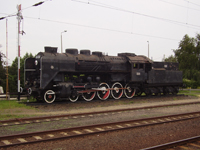
In Hungary steam-hauling came to an end in the late 1980's. But fortunately steam locomotives have not disappeared without any marks. Some of them have been preserved and restored in working order. Some of them, which were not cut up, have been exhibited at different railway stations as statues. The No. 424,353 'Buffalo' or 'Nurmi' (named after the endurance of the famous Finnish long-distance runner) steam locomotive found some 'shelter' at the station of Tokaj - a famous, historic small town in the North-Eastern part of Hungary - bearing the caprice and extremity of weather for many years, as when this photo was taken 1st July, 2006.
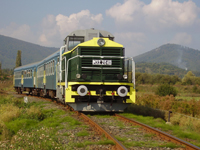
One of the Hungarian railway-photographer sites, Trains.hu organized its first photo-tour 30th September, 2006. The route was to travel along from the Northern Hungarian small town Vác via Diósjenő to the famous, historical small town Romhány and back. There were some stops on the open tracks to take photos about the train and the environment. The No. M32 2040 'Gokart' diesel shunter locomotive - which has been made under protection of listed technological work - belonging to the engine-house of Balassagyarmat, supplied the hauling power to our private train. The No. 75-76 railway side-lines in the valleys between the Hungarian mountains of the Börzsöny and Cserhát with the colorful autumn environment gave us a beautiful, very picturesque view. I took this photo about our short train when we stopped on open-line passing by Diósjenő station to the direction of Romhány.
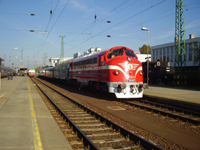
In the autumn of 2006 a travelling historical exhibition about the Hungarian Revolution in 1956 was established to commemorate its 50th anniversary. The exhibiton was travelling all around Hungary from town to town by railway. The No. 2761 017-9 'NoHAB' diesel-electric locomotive, which has been refurbished and restored some years ago for an international NoHAB-rendezvous, supplied the hauling power for this special train. Just to broaden the mind: The 'NoHAB'-locomotives are originnaly made in Sweden in the 1960's but their engines were made by General Motors in the USA. In Hungary only a few of them remained from the 20 MÁV (Hungarian State Railways)-locomotives. Some of them were cut up though they are known to be very reliable, but their parts were only for dollars in the socialist era of Hungary. In Nyíregyháza station - where this photo was taken - visitors could view the exhibition in the morning 26th October, 2006.
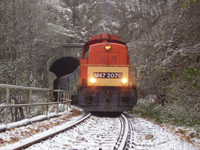
The route of the second Trains.hu-organized train-photographer tour lead to the 'Bakony', one of the Hungarian mountain chains 4th November. The No. 11 railway line winds in the valley of the 'Cuha' brook for a little way, which is a very beautiful view for photographers. There were some snowfalls that day and the previous day in Transdanubia, the Western part of Hungary. We were travelling also in snowfall during the bigger part of the tour. On this picture the No. M47 2070 'Big Dacia' diesel locomotive can be seen - which belongs to the Székesfehérvár engine-house - pulling our private train out of a tunnel between Vinye and Porva-Csesznek stations very slowly so that everybody could take some nice photos. This tour recalled the times when M47-type locomotives were haulight the passenger trains on that railway line.
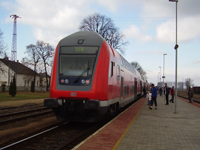
From the end of October to the mid-November 2006 a Bombardier-made DB (Deutsche Bahne = German Railroads)-operated double-decker train was travelling all around Hungary as slow and fast passenger trains. The train consisting of the DB's No. 8681 001-9 double-decker control car, two double-decker carriages and the No. 218-431-5 diesel locomotive was amazing the people everywhere it has been, because there has never been before such an interesting train in Hungary. People could fill in a form about the train during the travelling. I also had a chance to try this: I covered a 600 km distance on board of the train in two days. The photo was taken on the first day, 12th November, 2006 at Bánréve station. The 'magic train' was going from Miskolc-Tiszai railway station to Ózd station as No. 5412 slow train. The demonstration tour was not accidental, because the MÁV is planning to buy some double-decker suburban railway carriages in the near future.
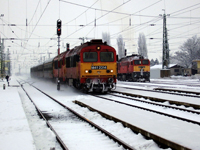
Snow started to fall quite late in Hungary in winter 2006. The first snowfall in my region, in the Northeaster part of Hungary was on the night by 29th December 2006. As I got in the morning up I immediately went to the railway station in Szerencs to take some nice photos. There I could notice this interesting locomotive-pair. The Miskolc-based No. M41 2314 'Rattler' remotorized diesel-electric locomotive helped to pull the No. M41 2120 - which also belongs to the Miskolc engine-house -, which didn't want to start at Sátoraljaújhely, station of departure of the No. 525 fast train to Budapest-Keleti railway station. In the background the No. M62 140 'Serghei' diesel-electric locomotive can be seen which had hauled a 30-wagon freight train to Szerencs. She belongs to the Székesfehérvár engine-house - far from Szerencs. She got here someway.
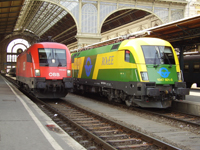
In the Western European countries it is very common to see a modern locomotive, and fortunately for the last few years also in Hungary. Some railway companies are represented by their locomotives at Budapest-Keleti, the busiest railway station of Hungary. On 25th March, 2007, the ÖBB (Österreichische Bundesbahnen = Austrian Federal Railways) No. 1116 023-1 'Taurus' electric locomotive was speeding out of the 9th platform in the hall of the station, after arriving with an InterCity train from Wien, capital of Austria. By her side at the 8th platform the half Hungarian, half Austrian owned GySEV (Győr-Sopron-Ebenfurthi Vasút = Győr-Sopron-Ebenfurth Railways) - or its Austrian equivalent ROeEE (Raab-Ödenburg-Ebenfurth Eisenbahn) or Raaberbahn (Raab Railway) for short - No. 1047 501-0 'Taurus' electric locomotive was waiting ready for departure with No. 924 fast train from Budapest-Keleti via Győr to Szombathely.
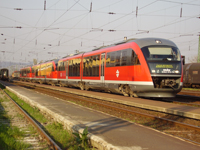
In the Railway Timetable 2007 of the MÁV (Hungarian State Railways) there is an InterCity train, No. 1521 going between Sátoraljaújhely - a North-Eastern Hungarian town - and Budapest-Keleti railway station (so along the No. 80 railway line) just on Sundays in school time that consists of two or three of the new Siemens Desiro DMU's (Diesel Multiple Unit). They were bought in 2002 by MÁV. In the picture No. 6342 013-7 can be seen speeding up out of Szerencs station with two mates No. 6342 015-2 and 6342 018-6 in the afternoon 1st April, 2007.

The No. 98 railway line, which can be found in Borsod-Abaúj-Zemplén, one of the North-Eastern counties of Hungary, lies between the small towns Szerencs, Abaújszántó and Hidasnémeti. It has a spectacular view all around: hills and mountains in various size everywhere. From the destination town, Hidasnémeti the Slovakian Tatra mountain-chains can also be seen. The line is splitted up into two sectors for years. The 21 km long southern part between Szerencs and Abaújszántó manages the biggest part of the traffic. The northern part between Abaújszántó and Hidasnémeti has just a few passengers - partly because of the ill-organized timetable. The most common railway vehicles of the southern sector are the Bzmot railcars which commute to and back in a consists of two railcars and two carriages between them. On the northern part just a single railcar commutes. The photo about the No. Bzmot 245 and Bzmot 328 railcars was taken at Abaújszántó station, 30th April, 2007.
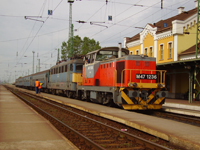
It is necessary to maintain the overhead wires from time to time. At this occasions wires are free from electricity, that's why electric locomotives can only pass by or stop, but they can't speed up again without any help. The wires were maintained in Szerencs station in the morning 8th May, 2007. That day No. M47 1236 remotorized 'Big Dacia' diesel locomotive, which belongs to the engine-house in Miskolc, was only for reserve in the station of the small town. She got the task to push the trains hauled by any electric locomotive under electricity. In the picture she helped the No. V43 1041 electric locomotive - which also belongs to Miskolc - to get its No. 5132 slow train, so as to be able to depart for Nyíregyháza station.

In Hungary No. 11 railway line between Győrszabadhegy and Veszprém stations had been put to the list of the railway lines to be closed by a paragraph of the current Hungarian economic policy called 'transport reform'. However fortunately it was saved after a revision because of turistic considerations. The No. Bzmot 308 railcar, which belongs to the engine-house of Székesfehérvár, with only one carriage as No. 39523 slow train was waiting at the starting point of the line, Győrszabadhegy station to depart for its destination, Veszprém in the afternoon 17th May, 2007. The short train was also waiting for its connections: the No. 923 fast train from Szombathely via Celldömölk and Pápa stations, and No. 9226 slow train from Győr via Pápa to Celldömölk. The photo has a momentary atmosphere because of the conductor was leaning on one of the plug of the railcar.
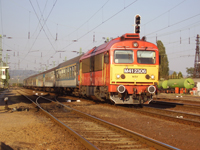
No. M41 2306 'Rattler' remotorized diesel locomotive, which belongs to the engine-house of Miskolc, was hauling No. 521 fast train from Sátoraljaújhely via Miskolc-Tiszai railway station - where the diesel locomotive is changed for an electric one - to Budapest-Keleti railway station. The locomotive was just arriving at the second platform of Szerencs station, when I took this photo in the sunny afternoon 17th September, 2007. In the background one of the south-eastern hills of the 'Zemplén' mountains can be seen.
My photo-gallery at kep.tar.hu
Trains.hu train-photographers
Galleries of photos about trains
If you want to write to me, you can do it here.